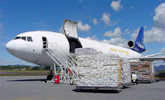Global capacity increased by 5.1 percent in January, when compared to the same period in 2013.
“The improvement in demand is good news. It is a step-up in pace from
the mild strengthening that we saw toward the second half of 2013. And
in real terms, volumes are similar to the 2010 post-recession peak,”
Tony Tyler, head of IATA, said in a statement. “But there is also ample
reason to be cautious. Protectionist measures are part of the reason for
a slower expansion of world trade than we would expect from current
levels of industrial production. Companies continue to re-organize
supply chains in their efforts to move manufacturing on-shore.”
North American carriers showed just a 0.7-percent, year-over-year
increase in activity, while capacity fell by 0.9 percent. IATA officials
believe that since manufacturing in the
U.S. is trending up, more robust cargo activity is in store. In contrast,
Middle Eastern carriers experienced the largest boost in activity of all
the regions IATA measures, seeing a 10.7-percent activity increase in
January. Capacity more than kept up the pace with an 11.5-percent growth
rate.
In its air freight market analysis, IATA noted that January’s results
reflect the highest cargo activity measured since the middle of 2010.
But the agency noted that world trade is only expanding in line with
industrial production growth (currently at between 3 percent and 4
percent) instead of the previous pace, which has seen trade expand over
industrial growth by a multiple of two. This, IATA said, means that air
freight growth will also be tamped down.
“Looking forward, air freight demand will likely continue to grow at
similar rates to industrial production and world trade – air freight’s
share of world trade remains stable, and there is no sign, at present,
of that share increasing,” IATA said.
American Shipper
